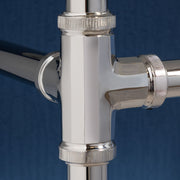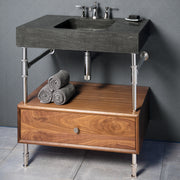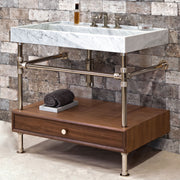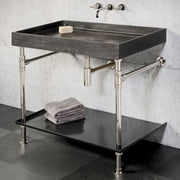Materials

Stone Forest designs are sculpted from single blocks of stone that were formed millions of years ago. A block of stone represents centuries of accumulated time and we like to think of them as “recorders of nature’s memory”.
As we cut into a block, a mystery is revealed as the unique characteristics of the stone come to light. These include individual fingerprints of nature, such as anomalies in the form of areas of enhanced coloration and unusual veining and swirls of color in the stone. Much of the actual carving is done by hand with calculated blows from a hammer and chisel. We also use small diamond saws and hand-held polishing tools, but because the sinks are not machined each will be a little different, and truly exceptional. They will not be perfectly symmetrical and there will be small variations in size. Each block of stone also has its own personality; expressed in slight differences in the makeup of its crystalline structure.
We hope our clients appreciate the wonders of natural stone and its unique characteristics. We never want to ask this incredible material to be something that it is not.
Click Here to Read More
Andesite is an extrusive igneous rock intermediate in composition between rhyolite and basalt. Andesite lava is of moderate viscosity and forms thick lava flows and domes. The lava cools quickly on the Earth's surface, resulting in a fine-grained texture with small crystals. The word andesite is derived from the Andes Mountains in South America where it is often found. It is also found in volcanoes along the margin of the Pacific Basin.
We cannot offer this material for custom designs at this time
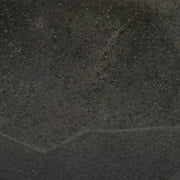
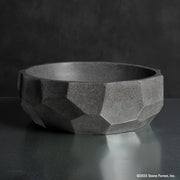
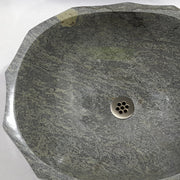
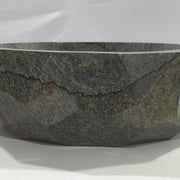
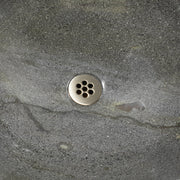
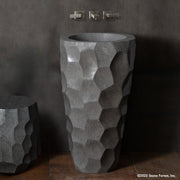
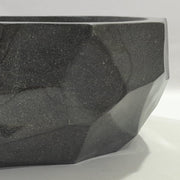
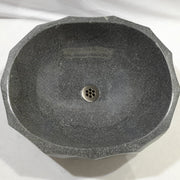
Antique gray limestone is a sedimentary rock that gets its charcoal gray color from the different minerals that fossilized in layers. The fossilization creates a natural subtle patterning that makes each piece truly unique. This stone has some non-structural inclusions that may appear as thin white lines.
Limestone is a highly variable material that contains color anomalies, non-structural fracture lines, and fossil remnants. There are typically some voids on the surface of the stone which must be filled with a stone epoxy that we color to match the stone as closely as possible. Take a look at the final pictures to see how sedimentary stones can vary depending on their formation
This stone is a good choice for custom designs
Fun Fact: Sedimentary rock is formed by the fusing of particles deposited by rivers, oceans, and lakes.
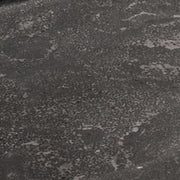
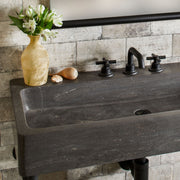
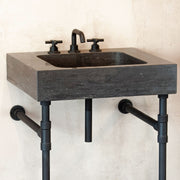
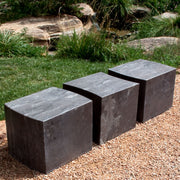
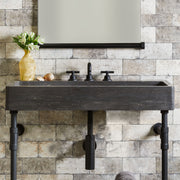
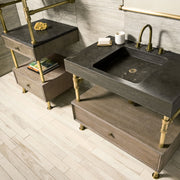
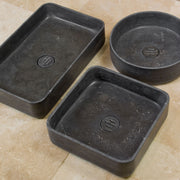
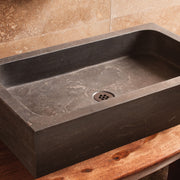
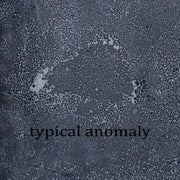
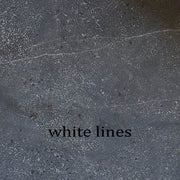
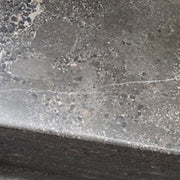
Bamboo Marble is considered a Breccia Marble. Breccia is a rock type characterized by large and angular mineral or rock fragments held together by a matrix of smaller particles and a mineral cement binding the rock together. It is distinct from a conglomerate, which is composed of rounded particles.
The word "breccia" comes from the Italian word for "broken" and refers to the shattered pieces of marble that are mixed with small rocks or stones.
We can only offer this material for garden items.
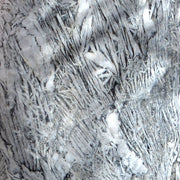

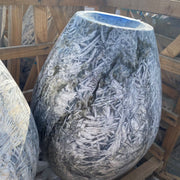

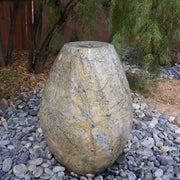
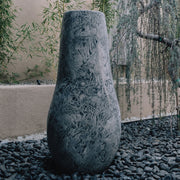

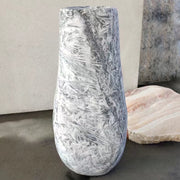
Basalt is an igneous (volcanic) material formed mostly from the rapid cooling of lava flows near the surface of our planet. Dense and durable, basalt lends itself to a wide range of sculptural applications.
In the kitchen and bath, we love basalt because it has the neutrality of dark concrete, coupled with the “radiant mass” of natural stone. In the garden, we use columnar basalt from a small, family-owned quarry in Inner Mongolia. These unusual columns are predominantly hexagonal in cross-section. We contrast the natural exterior that has weathered over thousands of years with polished facets that reveal the “soul” of the stone.
Please note: our basalt material has some non-structural inclusions that appear as thin white lines in the natural material.
This stone is a good choice for custom designs
Fun Facts: Basalt is the original constituent of the crust from which almost all other rock types have evolved. Basalt is also found on the Moon and other rocky planets of the Solar System.

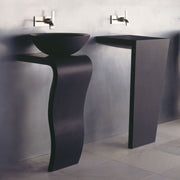
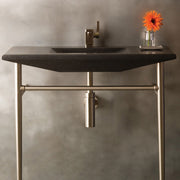
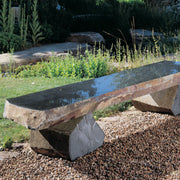
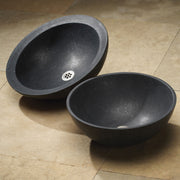
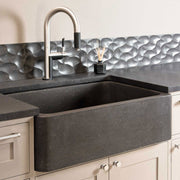
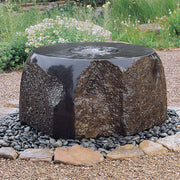
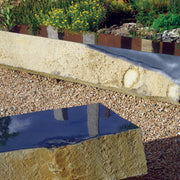
Beige Granite is one of the most commonly known types of rocks, used in everything from buildings to sculptures. It has been used for thousands of years and is regarded as a symbol of status, strength, and durability. Beige granite can be carved in a variety of textures, from a rustic, rough-chiseled surface to a high-polished one. For those who like the smooth finish of the polished, but want a matte look, the surface can be honed (matte).
Granite is a conglomerate of minerals and rocks, primarily quartz, potassium feldspar, mica, and amphiboles. These minerals create a stone that is beige in color with brown and black flecking. The color of beige granite ranges from a light, almost white, rosy color to deep gold.
Because this material is born from molten magma and forms over hundreds of years, some natural mineral deposits are to be expected. These show up as round or irregular-shaped anomalies that are silver, gold or copper in color. These anomalies are generally small but can range up to approximately one inch in diameter (about the size of a quarter). These inclusions are a part of the makeup of the natural stone.
This stone is a good choice for custom designs
Fun Fact: Granite is one of the hardest substances in the world, second only to diamonds.
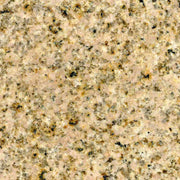
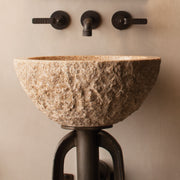
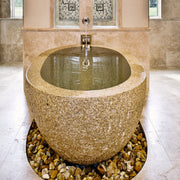

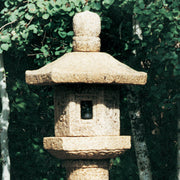
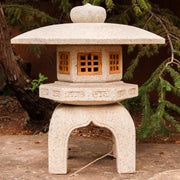
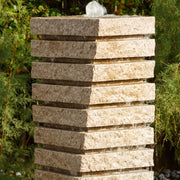
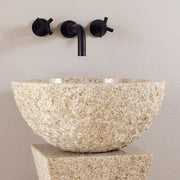
This massive, dark, dense, versatile material has gained widespread use throughout human history. Black granite can be carved in a variety of textures, from a rustic, rough-chiseled surface to a contemporary, high-polished one. For those who like the smooth finish of the polished, but want a matte look, the surface can be honed.
Because this material is born from molten magma and forms over hundreds of years, some natural mineral deposits are to be expected. These show up as round or irregular-shaped anomalies that are silver, gold or copper in color. These anomalies are generally small but can range up to approximately one inch in diameter (about the size of a quarter). These inclusions are a part of the makeup of the natural stone.
This stone is a good choice for custom designs
Fun Fact: Granite is the oldest igneous rock in the world, believed to have been formed as long as 300 million years ago. For those who’ve forgotten your high school science classes, igneous rocks are formed from cooling lava or magma.
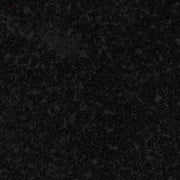
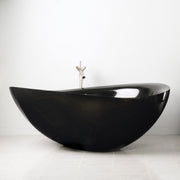
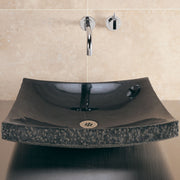

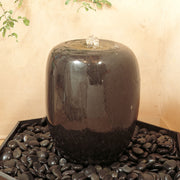
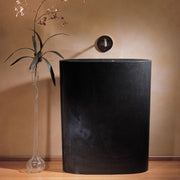
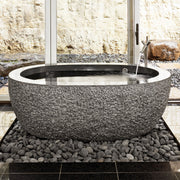
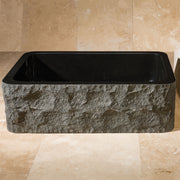
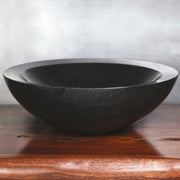
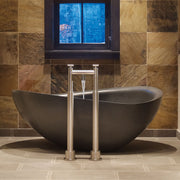
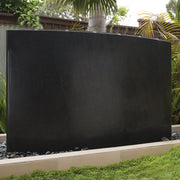
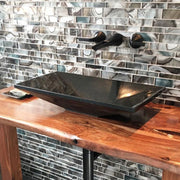
Granite is one of the most commonly known types of rocks, it has been used for thousands of years and is regarded as a symbol of status, strength, and durability. Bland and White Granite has equal parts quartz, feldspar, and amphibole, making a speckled black and white granite.
We use black and white granite for lanterns and fountains created using a knife-edge, bush-hammered or rough chiseled finish.
Because this material is born from molten magma and forms over hundreds of years, some natural mineral deposits are to be expected. These show up as round or irregular-shaped anomalies that are silver, gold or copper in color. These anomalies are generally small but can range up to approximately one inch in diameter (about the size of a quarter). These inclusions are a part of the makeup of the natural stone.
This stone is a good choice for custom designs
Fun Fact: The highest granite mountain in the world is Kangchenjunga in the Himalayas. At 8,586 meters, Kangchenjunga is the third-highest mountain in the world, behind Everest (which is limestone) and K2 (which is gneiss). Mount Rushmore is also sculpted out of granite.
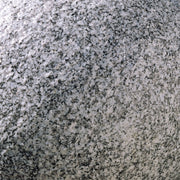
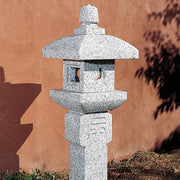
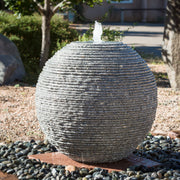
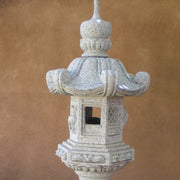
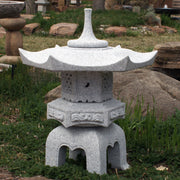
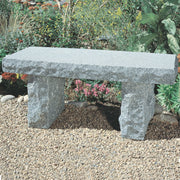
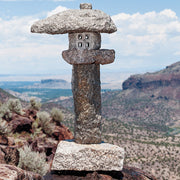
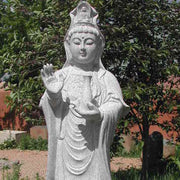
This massive, dense, versatile material has gained widespread use throughout human history. Gray granite can be carved in a variety of textures, from a rustic, rough-chiseled surface to a contemporary, high-polished one. For those who like the smooth finish of the polished but want a matte look, this would be a honed finish (matte).
Because this material is born from molten magma and forms over hundreds of years, some natural mineral deposits are to be expected. These show up as round or irregular-shaped anomalies that are silver, gold or copper in color. These anomalies are generally small but can range up to approximately one inch in diameter (about the size of a quarter). These inclusions are a part of the makeup of the natural stone.
This stone is a good choice for custom designs.
Fun Fact: An igneous rock is a rock that solidified from molten rock. This is in comparison to the two other major types of rock, sedimentary and metamorphic.
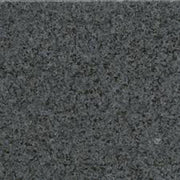
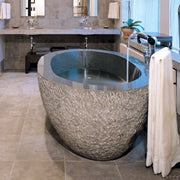
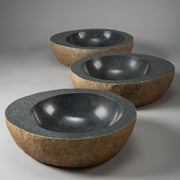
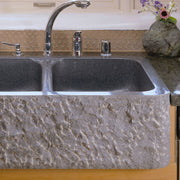
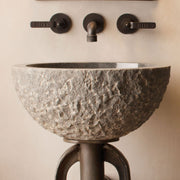
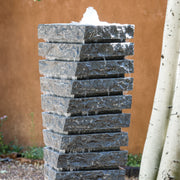
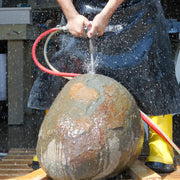
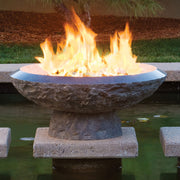
Our bronze vessel sinks are crafted using traditional sand-casting methods and feature a living finish that evolves over time and oxidizes naturally with use. Each bronze sink is made from 100% recycled materials. We offer White Bronze, Golden Bronze, and Weathered Bronze finishes.
- White Bronze is shown in the first row of photos
- Golden Bronze second row
- Weather Bronze third row
Humans have been smelting copper for 4500 years to create things. As technology improved, humans began mixing tin with copper to create alloys. This alloy is more commonly known as bronze. Copper lends its lustrous color to golden bronze creating a champagne-like color to the metal.
Bronze is widely used for cast metal sculptures and has been used throughout history in the creation of tools, weapons, and building materials. The alloy, traditionally composed of copper and tin, is harder and more fusible than pure copper and more resistant to corrosion than pure iron. The Bronze Age (3300 BC to 1200 BC), when ancient societies adopted it on a large scale, is nothing less than a major landmark in human history.
Santa Fe has occasionally been referred to as a city of sculpture. It's not hard to see why, when so many local artists have chosen bronze as their medium. While the vessels we cast are durable, the finish is more ephemeral. Living finishes are part of the beauty, changing and evolving with use.
We cannot offer this material for custom designs.
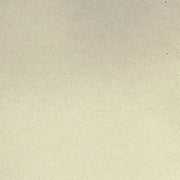
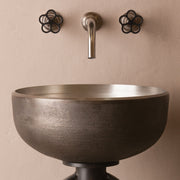


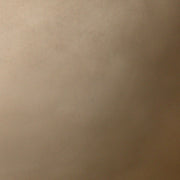

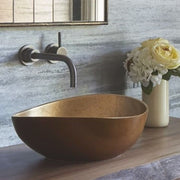

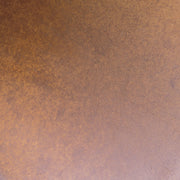

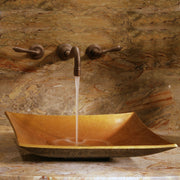
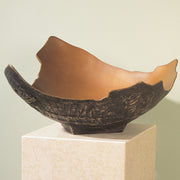
In its purest form, the natural luster of Carrara Marble brightens the ambiance in any home. Its history and widespread uses make it a prominent symbol for tradition and sophisticated tastes. We offer Carrara in a polished or honed (matte) finish. Marble is well-known for its durability and easy maintenance.
Carrara, Italy is the origin of this special marble. It has a white to a light gray background with gray veining. There are no two slabs of marble that have exactly the same pattern. This makes the stone unique but also means that you have to pay extra attention when choosing.
Marble is formed when limestone containing a lot of mineral calcite e.g. fossils are subjected to pressure and heat. The difference between limestone and marble lies in recrystallization. The content of other minerals in the rock defines the color of the marble.
Cararra Marble is a material that will vary in color and veining from piece to piece and sometimes from one side of the product to the other. This marble can also contain occasional anomalies (areas of enhanced coloration) and small white or black spots. Occasional voids in the surface of this marble must be filled with a stone epoxy that we color to match the marble as closely as possible.
This stone is a good choice for custom kitchen & bath designs
See the three photos in the bottom row for examples of common anomalies.
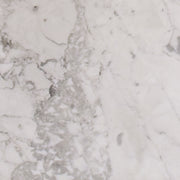

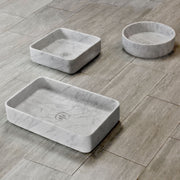
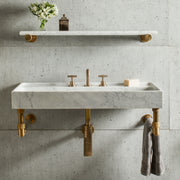
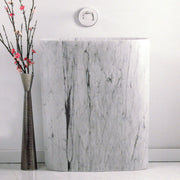
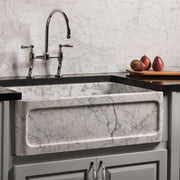
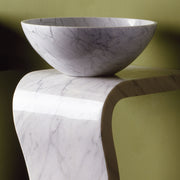
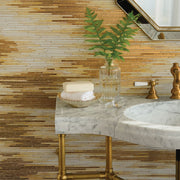

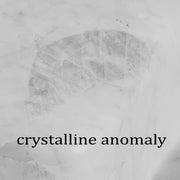
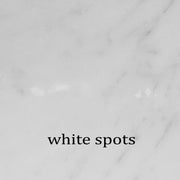
Our copper sinks are created from a hefty 16-gauge copper sheeting.
We offer copper in a hammered or smooth finish as shown below.
The farmhouse style is die pressed, and the lavatory sinks are handspun. Then the inside and outside shells are soldered together at the outer rim to create a sturdy durable double-wall construction. We sometimes combine copper and stainless steel. Some styles have a hand-hammered exterior. Some finishing marks, solder spots, and small impressions are the distinguishing traits of our handcrafted copper sinks and reveal the unique nature of each piece.
Copper is a living finish that naturally oxidizes when exposed to water and air. This oxidation is a dull green in color and makes up fractions of a millimeter of the metal’s surface. Oxidation can easily be removed from the surface if you want to keep the copper bright.
The way that we work with copper is unique in our industry and sets us apart in both aesthetic and quality. The fully double-walled construction of our copper sinks allows us to foam-fill the interior, which reduces reverberation. This also enables a number of mounting options for our Farmhouse-style Kitchen sinks, including under-mount, flush-mount, partially elevated and above counter.
We cannot offer this material for custom designs.
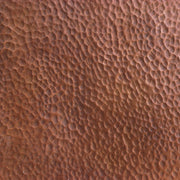
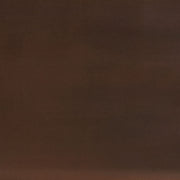
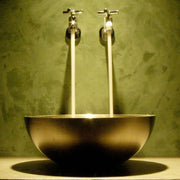
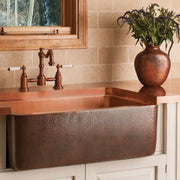
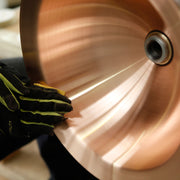
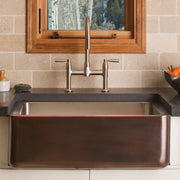
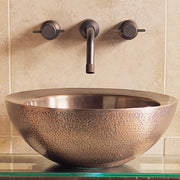
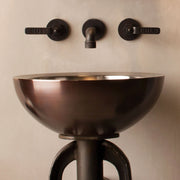
Granite is one of the most commonly known types of rocks, it has been used for thousands of years and is regarded as a symbol of status, strength, and durability. Cumulo granite can be polished or honed (matte).
The Cumulo granite is predominantly black and white crystals but also can have tan and pink crystals. The tan crystals can appear yellow in a different light. This is granite that underwent heat and pressure to reorganize the crystals and has areas of concentrated colors that can occur. The relative proportion of different colored minerals in granite is largely due to the original source of molten rock that cooled to form the granite.
Because this material is born from molten magma and forms over hundreds of years, some natural mineral deposits are to be expected. These show up as round or irregular-shaped anomalies that are silver, gold or copper in color. These anomalies are generally small but can range up to approximately one inch in diameter (about the size of a quarter). These inclusions are a part of the makeup of the natural stone.
This stone is a good choice for custom designs.
Fun Fact: Granite is also what’s called a “plutonic” rock, meaning that it forms deep underground. Granite is the main component that makes up the earth’s continental crust.
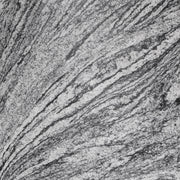
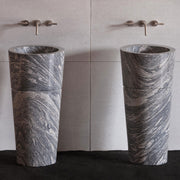
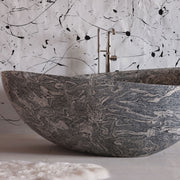
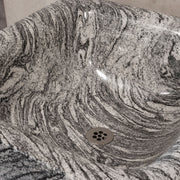
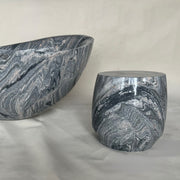
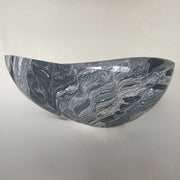
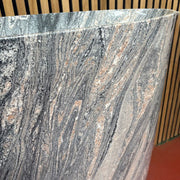
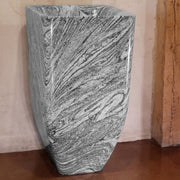
Limestone is a unique natural material formed over millions of years from compacted shells and skeletal fragments. As such, it is inherently variable in color, texture, and composition. Fossil inclusions, color variations, and surface voids are natural characteristics of this stone.
Any surface voids are filled by our craftsmen using a custom blend of ground limestone and epoxy, which we color-match as closely as possible to the surrounding stone.
If this level of natural variation is not acceptable for your project, we recommend considering an alternative material.
This stone is a good choice for custom kitchen & bath designs
Fun Fact: Many landmarks across the world are made of limestone, including the Great Pyramids in Giza, Egypt.
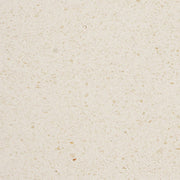
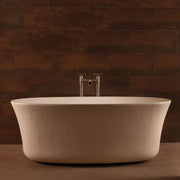
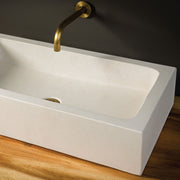

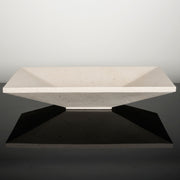
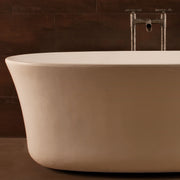
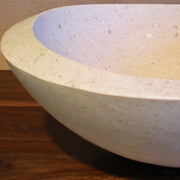
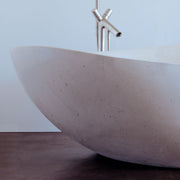
Green Marble is used only for our Garden designs. See Pebble Fountains and Pebble Seats.
Marble is formed when limestone contains a lot of mineral calcite e.g. fossils. These various impurities have been mobilized and recrystallized by the intense pressure and heat of the metamorphism. The difference between limestone and marble lies in recrystallization. The content of other minerals in the rock defines the color of the marble. Green coloration is often due to serpentine resulting from
originally magnesium-rich limestone or dolomite with silica impurities.
We can only offer this material for garden items.
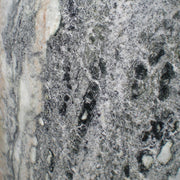
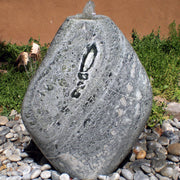
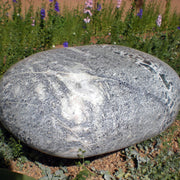
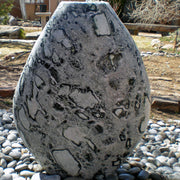
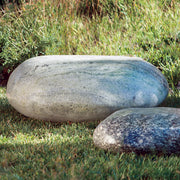
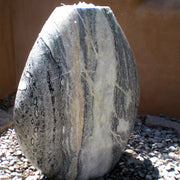
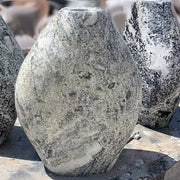
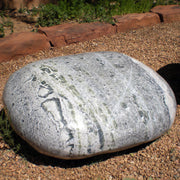
Sandstone, like its name implies, is comprised of layers of sand that have solidified into stone. It is very often visibly layered, though the layers can vary widely in width. Sandstone isn’t classified by any particular mineral makeup, but rather by the size of the particles that make up the stone.
Its layers of reds, browns, greys and other colors also make a stunning visual statement. Michael Zimber, owner of Stone Forest in Santa Fe, NM, is particularly inspired by this material. Each year he travels the globe, hand-picks the best pieces of sandstone and transforms them into hand-carved bathtubs, vessel sinks, and other creations.
To increase the durability of this naturally porous stone and to enhance the beauty, we offer these materials in a polished finish.
As the sand was deposited in estuaries and tidal flats eons ago, it also held random concentrations of minerals that now show up in the stone as spots, freckles, eye or colored patches. The occurrence of these mineral inclusions is a natural expression of this unique material. We do our best to select blocks from the quarry that carry a minimum of anomalies. Nonetheless, all of our Sandstone vessels carry some degree of anomalies.
This stone is sometimes available for custom kitchen & bath designs.
Fun Fact: Just about anywhere there is water, whether frozen or not, in a river or ocean, there is a chance to form sandstone.
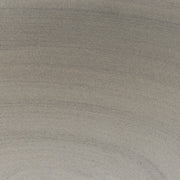
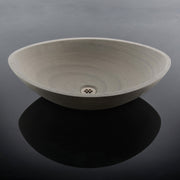
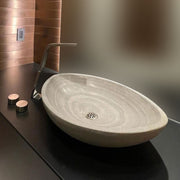
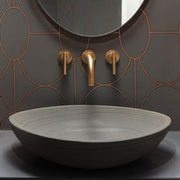
Honey Onyx material is used for our custom work only and is based on availability.
Onyx is a layered stone in many gorgeous colors. Honey Onyx has a combination of parallel banding and swirling design of caramel, tan, beige and ivory.
The stone is highly variable in terms of color, crystalline structure, and veining. Every Onyx product should be considered one-of-a-kind. The material not only varies significantly from block to block but within most individual blocks.
It's the perfect material for those looking to add a stunning, natural accent to interior and exterior environments.
The crystalline structure and deep colors of onyx are hypnotizing, said Michael Zimber, founder and owner of Santa Fe, NM-based Stone Forest, who travels the globe in search of the best pieces of onyx for his solid stone sinks, bathtubs, and fountains. Every time we make a new carving out of the material were taken on a journey through layer after layer of geological history and Mother Nature's beauty.
This materials is often available for custom kitchen & bath designs
Onyx fun facts The ancient Romans entered battle carrying amulets of onyx engraved with Mars, the god of war. This was believed to bestow courage in battle
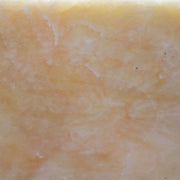
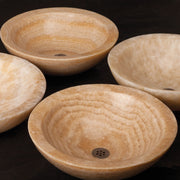

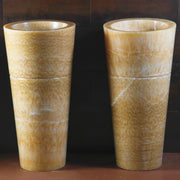
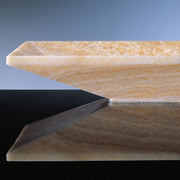
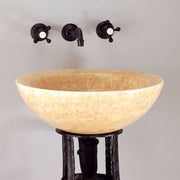

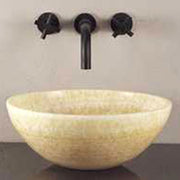
Jurassic is a sedimentary rock made of rounded pebbles and sand cemented together over hundreds maybe thousands of years by silica, calcite or iron oxide. The rock particles are rounded, formed in a high energy environment such as a beach or riverbed. The key characteristic is the visible, rounded clasts bound within a matrix. The clasts tend to feel smooth to the touch. This hard conglomerate rock is cut and polished to make dimension stone for our interesting-looking sinks and fountains.
We cannot offer this material for custom designs at this time.
FUN FACT: The presence of this Jurassic on Mars is compelling evidence that Mars once had flowing water: the pebbles in the rock are rounded, indicating they were transported along with a current and rubbed against one another. (Wind isn't strong enough to move pebbles this large.)
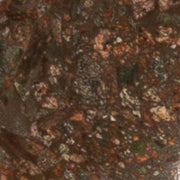
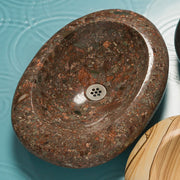
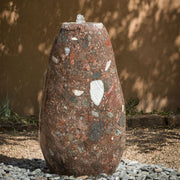
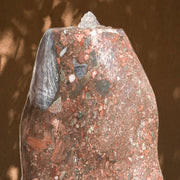
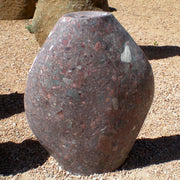
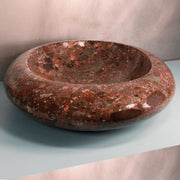
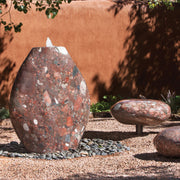
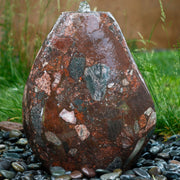
Luna Bianca Marble is primarily a white marble with clear colored quartz specs, it has varied grey and gold veining. All marble is a metamorphic rock composed of recrystallized carbonate minerals, most commonly calcite or dolomite creating the white tones.
Please note that this marble is a variable material that will vary in color and veining from piece to piece and sometimes from one side of the product to the other. This marble can also contain occasional anomalies (areas of enhanced coloration). Occasional voids in the surface of this marble must be filled with a stone epoxy that we color to match the marble as closely as possible.
This stone is is a good choice for custom kitchen & bath designs.
Fun Fact: Renaissance artists sought to improve upon the classics, but they were astonished by the keen sense of aesthetics shown by ancient Greeks and Romans. Michelangelo thought his ancestors brilliantly chose marble for their sculptures because of the elegant look of pure white stone. What he didn’t know is that these statues were garishly painted in various colors, but the pigments eventually faded away.
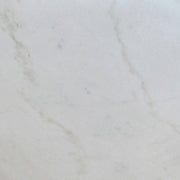
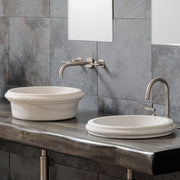
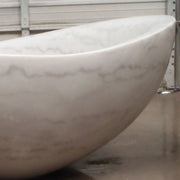
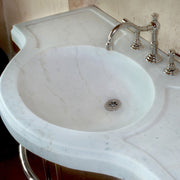
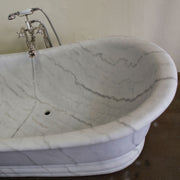
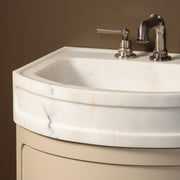
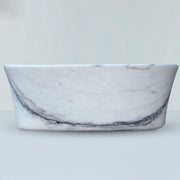
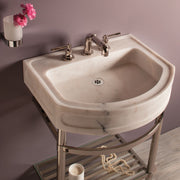
Marquina Taupe is a stunning contemporary marble. This marble is made up of a warm grey-brown background with striking white veining in different directions and thicknesses. The beauty of this natural stone is sophistication because of it’s versatile neutral on-trend colour that can complement any design scheme.
Marble is formed when limestone containing a lot of mineral calcite e.g. fossils are subjected to pressure and heat. The difference between limestone and marble lies in recrystallization. The content of other minerals in the rock defines the color of the marble.
Marquina Taupe marble is highly variable. The number, thickness and color of the veins will vary from block to block. The veins are mostly white, but some also have some brown/red/yellow colors in them. The background color also varies; ranging from light to dark gray and sometimes has areas that are brownish in color.
This stone is a good choice for custom kitchen & bath designs.
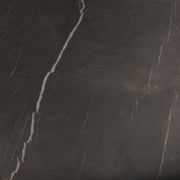
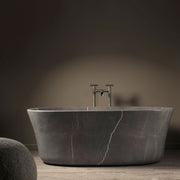

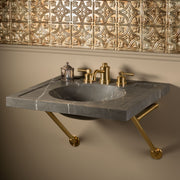
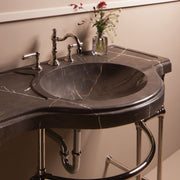
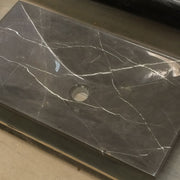
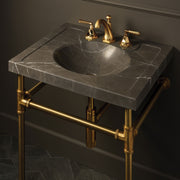
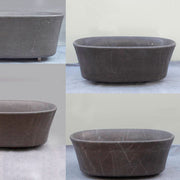
Multi-colored Onyx can range from pale green or ivory with very little veining or variation in color to something reminiscent of a wild abstract painting. This onyx is a layered stone in many gorgeous colors. The background colors are white, ivory or green. It is a quintessentially elegant stone with a combination of parallel banding and swirling veins in caramel, tan, brown and green.
It's the perfect material for those looking to add a stunning, natural accent to interior and exterior environments.
The crystalline structure and deep colors of onyx are hypnotizing, said Michael Zimber, founder and owner of Santa Fe, NM-based Stone Forest, who travels the globe in search of the best pieces of onyx for his solid stone sinks, bathtubs, and fountains. Every time we make a new carving out of the material were taken on a journey through layer after layer of geological history and Mother Nature's beauty.
Every one of our hand-carved, solid onyx creations is one-of-a-kind. Onyx is a highly variable material in terms of color, crystalline structure, and veining. The material not only varies significantly from block to block but within most individual blocks.
This stone is a good choice for custom designs.
Onyx fun facts: In Renaissance Europe, wearing onyx was believed to bestow eloquence.
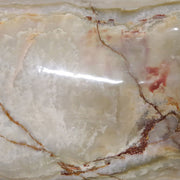
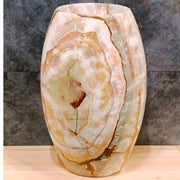
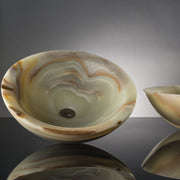
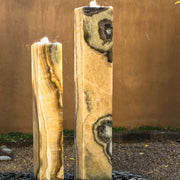
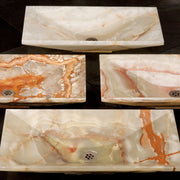
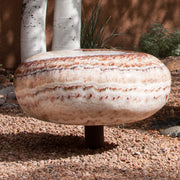
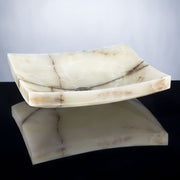
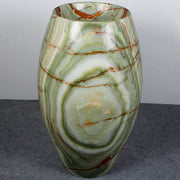
Nero Marquina, a classic Spanish marble that features a black base with striking white veining. Marble is a metamorphic rock consisting of carbonate minerals that recrystallize under the influence of heat and pressure.
This material is good for custom kitchen & bath designs.
Our nero marquina marble carries a high degree of variability. For instance, the amount and thickness of white veining will vary from block to block. Also, the black background may have some cloudiness (not a pure black background).
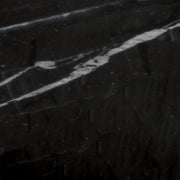
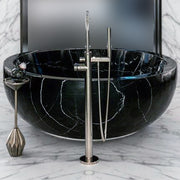
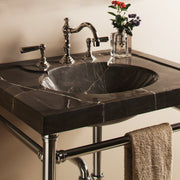
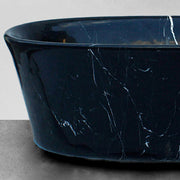
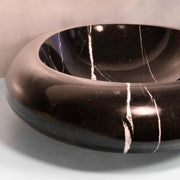
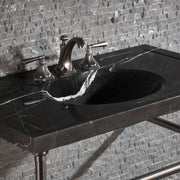
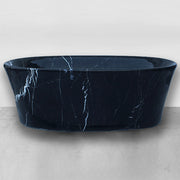
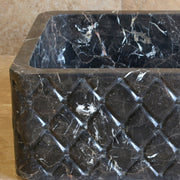
Noce Basalt is a warmer tone than our Basalt material. It is an igneous (volcanic) material formed mostly from the rapid cooling of lava flows near the surface of our planet. Dense and durable, basalt lends itself to a wide range of sculptural applications.
In the kitchen and bath, we love basalt because it has the neutrality of dark concrete, coupled with the “radiant mass” of natural stone. In the garden, we use columnar basalt from a small, family-owned quarry in Inner Mongolia. These unusual columns are predominantly hexagonal in cross-section. We contrast the natural exterior that has weathered over thousands of years with polished facets that reveal the “soul” of the stone.
This stone is a good choice for custom kitchen & bath designs.
Please note: our basalt material has some non-structural inclusions that appear as thin white lines in the natural material. An example is shown on the second row first photo.
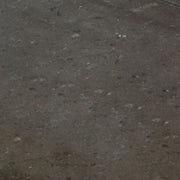
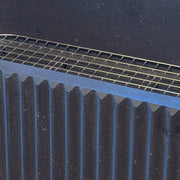

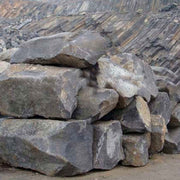
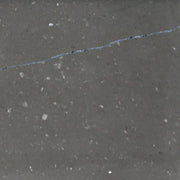
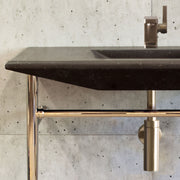
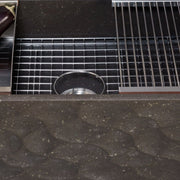
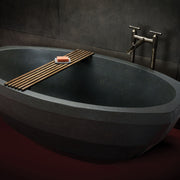
Papario Cream marble is quarried in Egypt. It is one of the oldest and the finest marbles in the world. This marble is famous for its luscious luster and visual appeal.
It is a medium grained sedimentary rock that is light creamy beige with golden shades that can be honed, polished, bush-hammered.
Please note that papiro cream marble is a highly variable material that contains color anomalies, non structural fracture lines, and inconsistent veining. There are typically some voids in the surface of the stone which necessitate filling with a stone epoxy that we color to match the marble as closely as possible.
This stone is a good choice for custom kitchen & bath designs.
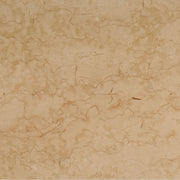
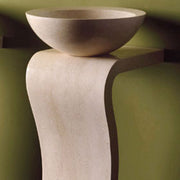
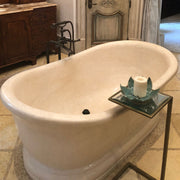
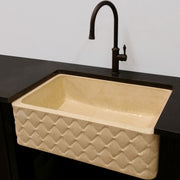
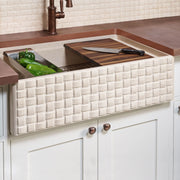
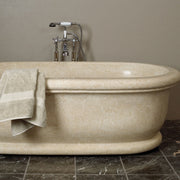
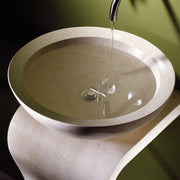
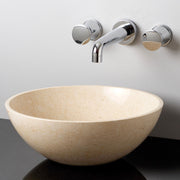
Purple Onyx ranges from a deep purple to a light lavender with some white veining, occasionally a complementary green makes an appearance. The stone is highly variable in terms of color, crystalline structure, and veining. Every Onyx product should be considered one-of-a-kind. The material not only varies significantly from block to block but within most individual blocks.
It's the perfect material for those looking to add a stunning, natural accent to their bathroom environment.
The crystalline structure and deep colors of onyx are hypnotizing, said Michael Zimber, founder and owner of Santa Fe, NM-based Stone Forest, who travels the globe in search of the best pieces of onyx for his solid stone sinks, bathtubs, and fountains. Every time we make a new carving out of the material were taken on a journey through layer after layer of geological history and Mother Nature's beauty.
Our Purple onyx is often classified as fluorite.
We cannot offer this material for custom designs at this time.
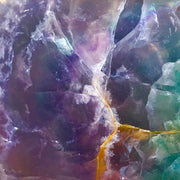
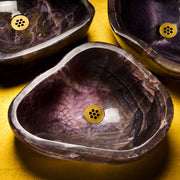
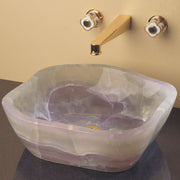
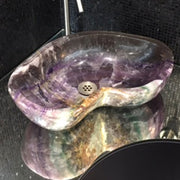

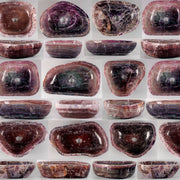
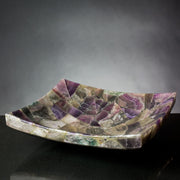
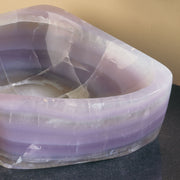
Sandstone, like its name implies, is comprised of layers of sand that have solidified into stone. It is very often visibly layered, though the layers can vary widely in width. Sandstone isn’t classified by any particular mineral makeup, but rather by the size of the particles that make up the stone.
Its layers of reds, browns, greys and other colors also make a stunning visual statement. Michael Zimber, owner of Stone Forest in Santa Fe, NM, is particularly inspired by this material. Each year he travels the globe, hand-picks the best pieces of sandstone and transforms them into hand-carved bathtubs, vessel sinks, and other creations.
To increase the durability of this naturally porous stone and to enhance the beauty, we offer these materials in a polished finish.
As the sand was deposited in estuaries and tidal flats eons ago, it also held random concentrations of minerals that now show up in the stone as spots, freckles, eye or colored patches. The occurrence of these mineral inclusions is a natural expression of this unique material. We do our best to select blocks from the quarry that carry a minimum of anomalies. Nonetheless, all of our Sandstone vessels carry some degree of anomalies.
This stone is a good choice for custom kitchen & bath designs.
Fun Fact: Just about anywhere there is water, whether frozen or not, in a river or ocean, there is a chance to form sandstone.
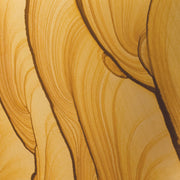
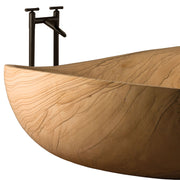
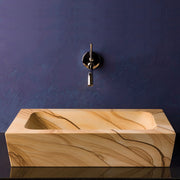
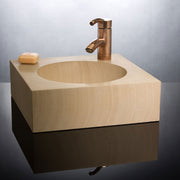
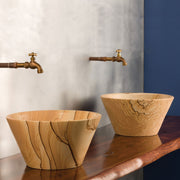
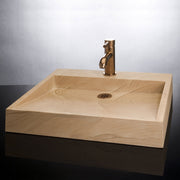
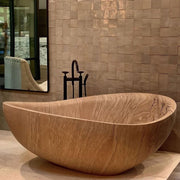
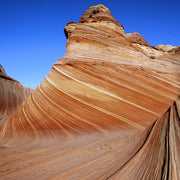
Marble is a natural stone that has amazed people with its mesmerizing beauty and unique qualities since the dawn of time. Siena Silver Gray is a beige/grey “wooden” veined marble quarried in Italy.
We introduced this new type of stone to the K&B world, it is a very fine-grained marble. Take a look at the sample photos, for a close-up of the details in this unique material. Look at the lively pattern of sedimentary veins and cross-bedded vein lines that are characteristic of this stone. We chose this marble for its streaked grey/tan tones. This striking material features subtle smoky tones and natural contrasting striations. It is featured by a full suite of bath sculpture, named the Siena Collection, designed for the home and spa which combines minimalist design with an Italian sensibility.
This stone is a good choice for custom designs.
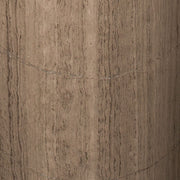
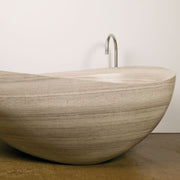
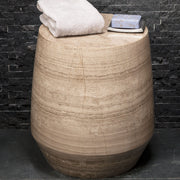
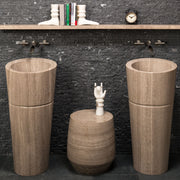
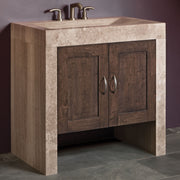
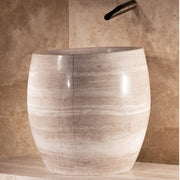
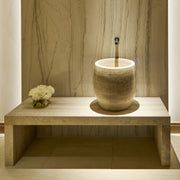
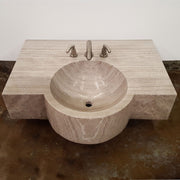
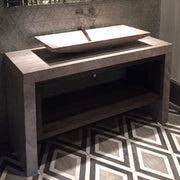
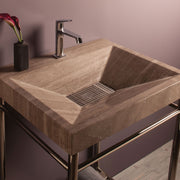
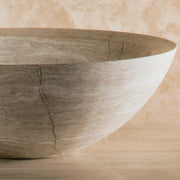
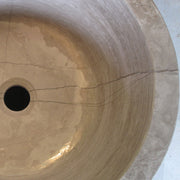
Silver Travertine is a beautiful blend of earth tone colors, including tans, beige silvers, and creams. The hues create the feel of watercolor painting; it is certain to bring sophistication and understated elegance to any bathroom.
Travertine is a terrestrial sedimentary rock, formed by the precipitation of carbonate minerals deposited by mineral springs. This natural stone has a porous structure as one of its inherent characteristics. These voids must be filled with grout that we color to match the stone as closely as possible.
This stone is a good choice for custom designs.
Fun Fact: During the Roman Empire, it was a popular building material. It was used to build aqueducts, pillars, walls, and floors. The Colosseum is built from travertine.
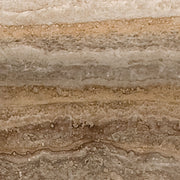
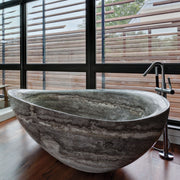
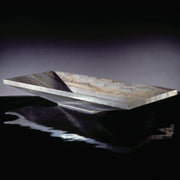
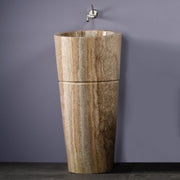
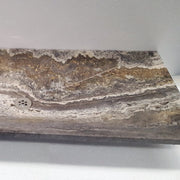

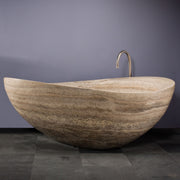
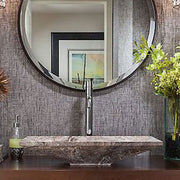
Our stainless steel sinks are made by drawing a sheet of 18 gauge stainless steel over a die where it's then pressed, then finished in a brushed metal or polished look.
Most of our copper and stainless sinks have inside and outside shells soldered together at the outer rim to create a sturdy durable wall construction. Some styles have a hand-hammered exterior.
Stainless steel is more than just pretty looks, it offers many advantages, it’s high corrosion resistance, it is resistance to fire and heat allowing it to resist scaling and retain strength at high temperatures. It doesn’t chip, bends, or crack easily and it stays shiny over years of use.
Simply put, stainless steel is one of the most durable, versatile, and worry-free metals available. It’s hard to argue with that!
We cannot offer this material for custom designs.
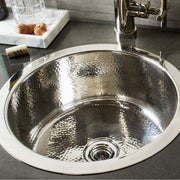
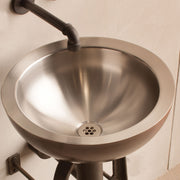
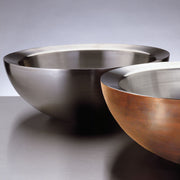
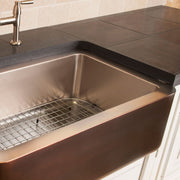
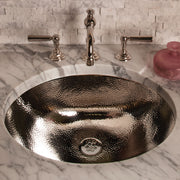
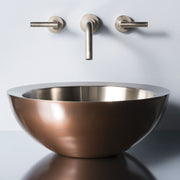
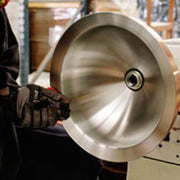
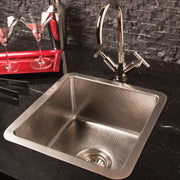
Verde Indio Marble is a stunning natural stone known for its vibrant green tones and intricate veining patterns with pale green to nearly black terrazzo-like patterning throughout. It is quarried in India and features a rich, deep green color ranging from emerald to forest green, creating a visually captivating effect. The polished surface enhances the marble's innate beauty, bringing a touch of elegance and natural charm to interior spaces with its unique blend of color and character.
This stone is a good choice for custom kitchen & bath designs.
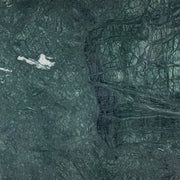
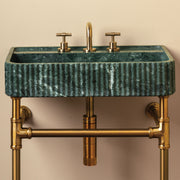

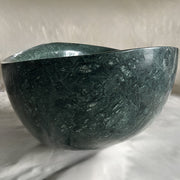
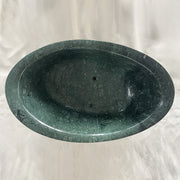
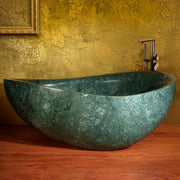
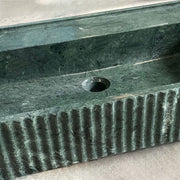
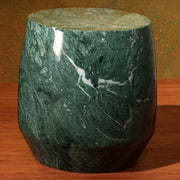
Viola Bianco marble is sourced from Italy. It is a stunning marble characterized by lilac-colored veining and a pure white background. The uniqueness of Viola makes this marble a perfect choice for adding a touch of opulence. It is known for its dramatic veining on a white background. The stone is strong and durable.
This stone is a good choice for custom kitchen & bath designs.
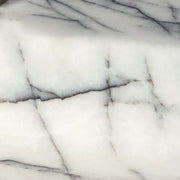
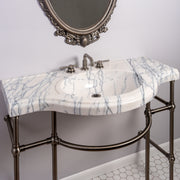
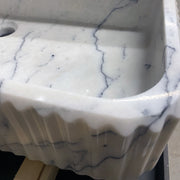
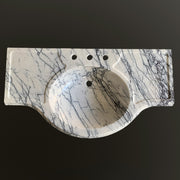
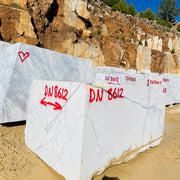
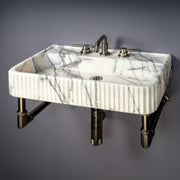
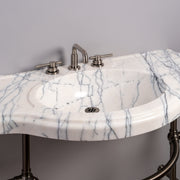
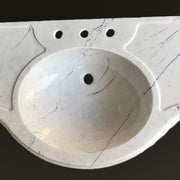
White Onyx ranges from white to creamy white with yellow, reddish or rusty colored veining to the very rare almost pure white. It's the perfect material for those looking to add a stunning, natural accent to their bathroom environment.
The crystalline structure of this sometimes translucent onyx are extraordinary, said Michael Zimber, founder and owner of Santa Fe, NM-based Stone Forest, who travels the globe in search of the best pieces of onyx for his solid stone sinks. Every time we make a new carving out of the material were taken on a journey through layer after layer of geological history and Mother Nature's beauty.
Every one of our hand-carved, solid onyx creations is one-of-a-kind. Onyx is a highly variable material in terms of color, crystalline structure, and veining. The material not only varies significantly from block to block but within most individual blocks.
This stone is sometimes available for custom kitchen & bath designs.
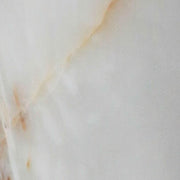
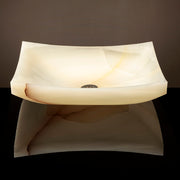
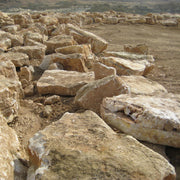

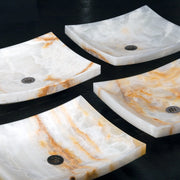
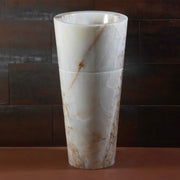
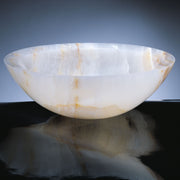
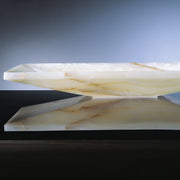
Using nature as our blueprint, we create functional sculpture crafted from thick slabs of sustainable hardwood. Handcrafted using traditional mortise and tenon joinery, you won’t find any nails in our work. Our designs emphasize the natural or outer edge of the tree as well as other unique characteristics including burls, knotholes and naturally occurring checks/ cracks. In order to create a sustainable product, we mill small growth trees and laminate the planks together to create an old-growth, large slab look. The slabs contain a mix of heartwood and sapwood, with resulting variations in light and dark grain. Butterfly joints are used both to control cracks and for purely decorative reasons. All of our furniture reflects the individual characteristics of the tree from which it was made and each piece is one-of-a-kind.
The products are finished with a three-coat sealing process, enhancing the natural beauty of each piece. Our Polyurethane sealer contains no VOC’s
We cannot offer custom wood designs
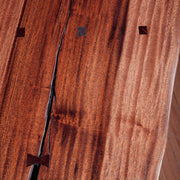
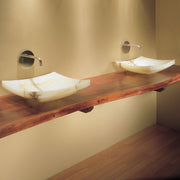
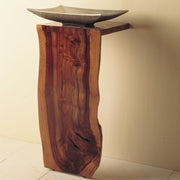
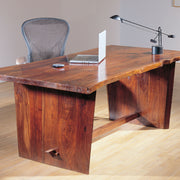
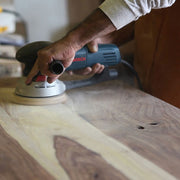
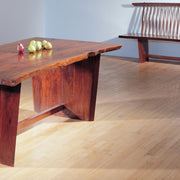
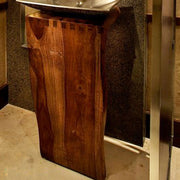

Our Elemental Wood components are constructed using veneered cabinet-grade plywood and finished with three coats of water-based sealer, making them ideal for use in bathrooms.
Shown here is our standard finish, a cement gray wash over oak
We cannot offer custom work in this material
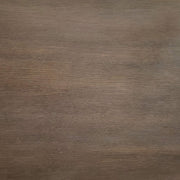
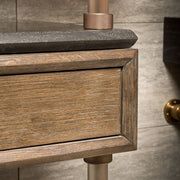
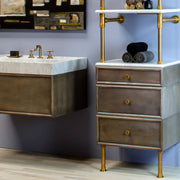
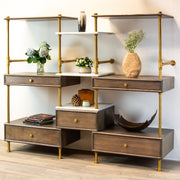
Our Elemental Wood components are constructed with high-quality veneered cabinet-grade plywood and finished with three layers of water-based sealer that can withstand the moisture of the bathroom.
We cannot offer custom work in this material
The walnut finish shown here is a beautiful example of our work.
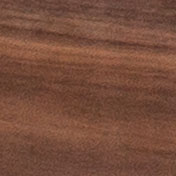
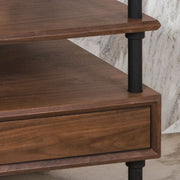
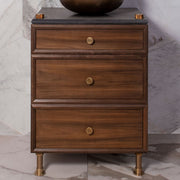
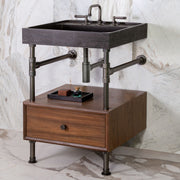
Aged Brass finish is raw brass that has been chemically darkened to simulate aged brass. It is rich and warm, with hints of gold woven throughout and can vary because it is a living finish. To define the living finish quite simply, it's brass that has no protective lacquer causing it to deepen in hue over time. Living finishes are intentionally designed to change over time and develop a unique patina, which can be a desirable characteristic.
See our configurators for custom setups

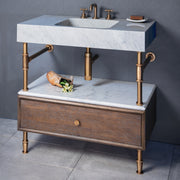
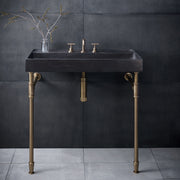
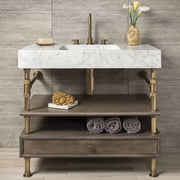
Graphite is a truly remarkable hue when it comes to enhancing the visual appeal of any room or space. This particular shade of gray is achieved through the meticulous blending of blue, white, and black, resulting in a refined and sophisticated appearance that exudes class and elegance. It's worth noting that even though graphite is classified as a living finish, it won't undergo any significant changes over time. This makes it a highly stable and reliable color choice that is sure to endure the test of time, maintaining its aesthetic appeal for years to come. So if you're looking to add a touch of sophistication, graphite is definitely an option worth considering
See our configurators for custom setups
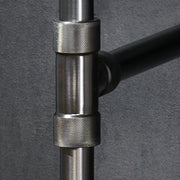
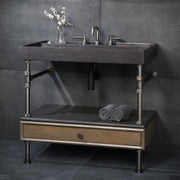
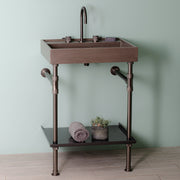

Matte Black finish is a highly adaptable and visually stunning choice that seamlessly complements a wide range of design styles. Its contemporary aesthetic is inspired by the sleek and clean lines of Bauhaus architecture, the intricate patterns found in wrought iron fences, and the timeless elegance of fixtures crafted by blacksmiths in the Colonial Era. This exquisite finish boasts a satin-like appearance with a subtle black color and is expertly crafted through a process of brass plating, copper immersion, and application of a specially formulated black solution. It's worth noting that even though matte black is classified as a living finish, it won't undergo any significant changes over time. This makes it a highly stable and reliable color choice that is sure to endure the test of time.
See our configurators for custom setups
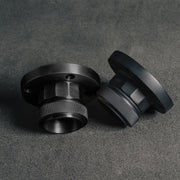
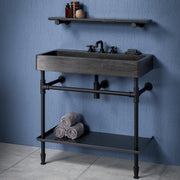
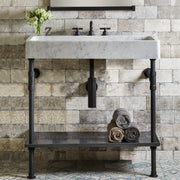
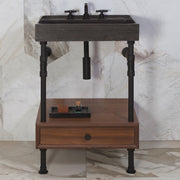
The creation of Polished Nickel finish involves polishing brass that has been plated with nickel, resulting in a silver appearance. It's worth noting that nickel has a warmer tone than chrome. This finish is un-lacquered and classified as a living finish, but it will not darken over time like brass. This is because nickel maintain its luster, making it a reliable and low-maintenance option.
Overall, the Polished Nickel finish's unique blend of elegance and durability makes it an excellent choice for a wide range room designs.
See our configurators for custom setups
